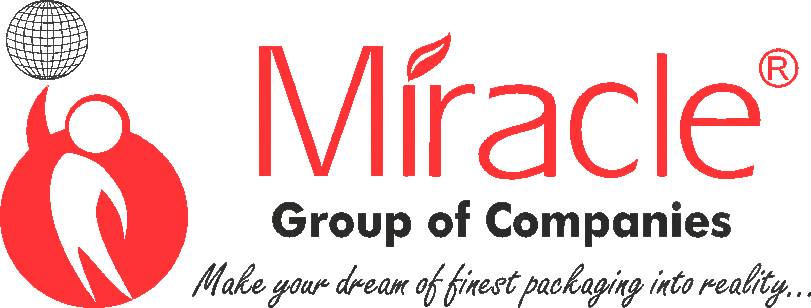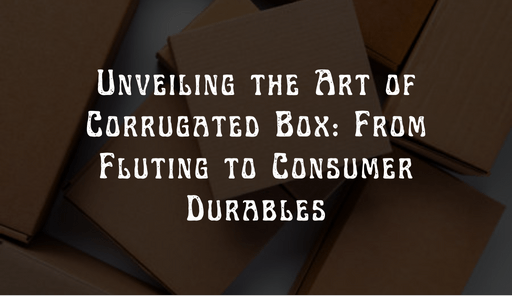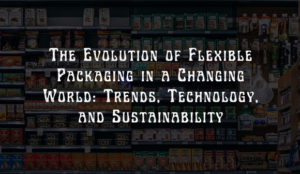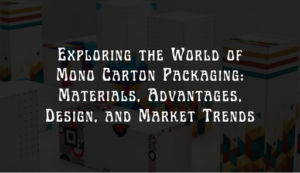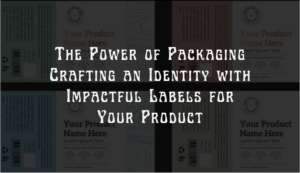In the world of packaging solutions, corrugated boxes stand out as versatile, durable, and eco-friendly choices. As businesses increasingly prioritize sustainable practices, the demand for corrugated packaging has soared. This comprehensive guide explores the intricacies of corrugated box construction, the corrugation process, and the vital role they play in the booming consumer durables and e-commerce industries.
Understanding the Basics of Corrugated Box Construction
Corrugated boxes are marvels of engineering, providing strength and rigidity while remaining lightweight. The basic construction involves three layers: an inside liner, an outside liner, and a corrugated medium sandwiched between them. This construction imparts the boxes with the ability to withstand pressure, ensuring the safety of the contents during transportation and handling.
Exploring the Process of Corrugation and the Essential Raw Materials
The corrugation process is a fascinating journey that transforms sheets of paper into resilient packaging. This process involves feeding paper through a series of rollers, creating the characteristic waves or flutes that give corrugated boxes their strength. The essential raw materials include paperboard, which is composed of layers of paper that are glued together, creating a sturdy foundation for the corrugation process.
Diving into the Various Fluting Types in Corrugated Boxes
Fluting is a critical aspect of corrugated box design, influencing its strength, cushioning ability, and overall performance. There are several types of flutes, each with its unique characteristics. Single-face, single-wall, and double-wall corrugated box offer varying degrees of protection, making them suitable for different applications.
There are several types of fluting, and each type has specific characteristics that make it suitable for different applications. The most common fluting types include:
-
A-Flute:
- Largest flute profile.
- Offers excellent cushioning and stacking strength.
- Used for packaging fragile and heavy items.
-
B-Flute:
- Smaller and more numerous waves compared to A-flute.
- Provides a smooth surface for printing.
- Suitable for retail packaging, displays, and die-cut boxes.
-
C-Flute:
- Intermediate size between A and B flute.
- Balanced strength and cushioning.
- Widely used for shipping boxes and retail packaging.
-
E-Flute:
- Very small and dense waves.
- Provides a flat surface for printing.
- Suitable for high-quality printing and packaging of lightweight products.
The choice of fluting type depends on various factors, including the weight and fragility of the packaged items, printing requirements, and the intended use of the box. Understanding the characteristics of each fluting type helps manufacturers and packaging designers select the most appropriate option for a particular application.
Exploring the various fluting types involves considering the structural and performance differences between them, as well as how these differences align with specific packaging needs. It’s an essential aspect of corrugated box design and production to ensure that the packaging effectively protects its contents during storage, transportation, and handling.
Growth of Consumer Durables & E-Commerce
The consumer durables and e-commerce sectors have witnessed exponential growth in recent years. As these industries flourish, the demand for reliable and sustainable packaging solutions has risen. Corrugated box has emerged as the preferred choice due to their ability to provide protection, customization options, and eco-friendly attributes.
Unraveling the Significance of Paper Quality
Paper quality plays a pivotal role in determining the durability and performance of corrugated box. Manufacturers must carefully select paper that meets specific strength and thickness requirements. High-quality paper ensures that the corrugated box maintain their structural integrity, even in challenging shipping conditions.
-
Print Quality:
- In the printing industry, the quality of paper directly affects the sharpness and clarity of printed images and text.
- High-quality paper with a smooth surface allows for better ink absorption and results in vibrant colors and sharp details.
-
Durability and Strength:
- Paper quality determines the strength and durability of the final product.
- For applications like packaging, a higher-quality paper with good tensile strength and tear resistance ensures that the packaging can withstand handling, transportation, and environmental factors.
-
Texture and Feel:
- Different paper qualities offer various textures and tactile experiences.
- For products like brochures, invitations, or luxury packaging, the choice of paper quality contributes to the overall aesthetic and perceived value.
-
Longevity and Archival Properties:
- Archival-grade paper is designed to resist deterioration over time, making it suitable for preserving important documents, books, and historical records.
- High-quality paper with acid-free properties helps prevent yellowing and degradation.
-
Absorbency and Ink Compatibility:
- Paper quality affects how well it absorbs ink. Proper ink absorption is essential for achieving optimal print results.
- The choice of paper should also be compatible with the type of ink used, especially in applications like offset printing or inkjet printing.
-
Environmental Impact:
- The quality of paper can be linked to its environmental impact. Recycled paper or sustainably sourced paper contributes to environmentally friendly practices.
- Many industries and consumers prioritize eco-friendly paper options to reduce the overall environmental footprint.
-
Application-Specific Requirements:
- Different applications, such as writing, packaging, labeling, and art, have unique requirements for paper quality.
- For example, writing paper should have a smooth surface for easy writing, while packaging paper needs to balance strength and flexibility.
-
Brand Image and Perception:
- The quality of paper used in promotional materials, packaging, or publications can influence how a brand is perceived.
- High-quality materials often convey a sense of professionalism and attention to detail.
Importance and Characteristics of Golden Brown Paper
Golden brown paper, often associated with natural and earthy tones, holds importance in various applications. The characteristics of golden brown paper contribute to its versatility and aesthetic appeal. Here are the importance and characteristics of golden brown paper:
Importance:
-
Natural Appearance:
Golden brown paper is often associated with a natural, organic, and earthy appearance. It is reminiscent of natural fibers and can convey a sense of warmth and authenticity.
-
Eco-Friendly:
Many golden brown papers are made from recycled materials or are part of sustainable and eco-friendly production processes. This aligns with the growing awareness and preference for environmentally conscious choices.
-
Versatility:
Golden brown paper is versatile and can be used in various applications, including packaging, crafts, stationery, and artistic projects. Its neutral color complements different design styles.
-
Craftsmanship and Artistry:
The warm and inviting color of golden brown paper is often associated with craftsmanship and artistry. It can be used to enhance the visual appeal of handmade items, invitations, and artistic creations.
-
Brand Image:
In packaging, golden brown paper can contribute to a brand’s image, especially if the brand emphasizes natural or eco-friendly values. It can convey a sense of authenticity and a connection to nature.
Characteristics:
-
Color:
The most prominent characteristic is the golden brown color, which can range from a light tan to a deeper, richer hue. This color is achieved through various methods, including the choice of raw materials and the manufacturing process.
-
Texture:
Golden brown paper often has a natural and slightly textured surface. The texture can vary based on the specific type of paper and its intended use, ranging from smooth to a more rustic texture.
-
Durability:
Depending on the specific type of golden brown paper, it can exhibit different levels of durability. Some varieties may be suitable for lightweight applications, while others may offer more robust strength for packaging.
-
Printability:
Golden brown paper can be designed to be printable, allowing for custom branding, labeling, or artistic designs. The printability of the paper depends on factors such as surface smoothness and coating.
-
Environmentally Friendly:
Many golden brown papers are made from recycled content or sourced from sustainable forestry practices. This characteristic aligns with the demand for environmentally friendly and socially responsible materials.
-
Applications:
Golden brown paper finds applications in a wide range of products, including gift wrapping, shopping bags, envelopes, notebooks, and various artistic projects. Its adaptability makes it suitable for both functional and aesthetic purposes.
Identifying Key Factors Influencing the Choice of Paper Quality
The choice of paper quality is influenced by several factors, including the type of product being packaged, the shipping conditions, and brand image. Sustainable packaging has gained prominence, leading to an increased focus on eco-friendly materials. Corrugated packaging companies are now adopting practices that prioritize both performance and environmental responsibility. Here are some key factors:
-
Print Requirements:
The printing method used (e.g., offset, digital, inkjet) affects the choice of paper. Different papers interact differently with inks and printing processes, influencing the final print quality.
-
End Use/Application:
The intended application of the paper is crucial. For example, packaging paper needs to balance strength and durability, while writing paper requires a smooth surface for ease of writing.
-
Weight and Thickness:
The weight and thickness of the paper impact its feel, durability, and functionality. Thicker papers are often perceived as more substantial and can be suitable for luxury packaging or premium printed materials.
-
Durability and Strength:
Depending on the use, the paper may need to withstand handling, transportation, or environmental factors. Packaging materials, for instance, should have the strength to protect the contents.
-
Environmental Considerations:
Sustainability and environmental impact are increasingly important factors. Many businesses and consumers prefer papers made from recycled materials or sourced from sustainable forestry practices.
-
Color and Appearance:
The color and appearance of the paper contribute to the overall aesthetic of the final product. Whether it’s a bright white, natural beige, or a specific color tint, it should align with the desired visual effect.
-
Texture and Finish:
The texture of the paper surface (smooth, textured, coated, uncoated) can influence the tactile experience and appearance. A specific finish, such as matte or glossy, may be chosen based on the desired look and feel.
-
Archival Properties:
For documents or materials that need to be preserved over time, archival-grade paper with acid-free properties may be essential to prevent deterioration.
-
Cost Considerations:
Budget constraints play a role in the selection of paper. Higher-quality papers or specialty finishes may come at a higher cost, and finding a balance between quality and budget is crucial.
-
Printing Volume:
The volume of printing can impact the choice of paper. For large print runs, factors like paper cost, availability, and runnability through printing equipment become crucial.
-
Brand Image:
The paper chosen can contribute to the overall brand image. Premium brands may opt for high-quality, luxurious papers to convey a sense of quality and sophistication.
-
Regulatory Compliance:
In certain industries, there may be regulations or standards that dictate the type of paper that can be used, such as food-grade paper for packaging edible products.
-
Supplier Relationships:
Established relationships with paper suppliers can influence the choice of paper. Familiarity with a particular supplier’s range of products, reliability, and service can be factors.
Explore the Branded Corrugated Packaging
Branded corrugated packaging refers to the use of customized and branded designs on corrugated box and packaging materials. This approach goes beyond using generic, plain packaging and allows businesses to create a unique and recognizable identity for their products. Here are some aspects to explore regarding branded corrugated packaging:
-
Custom Printing:
- Branded corrugated packaging involves custom printing of logos, brand colors, and other visual elements directly onto the corrugated material. This customization helps reinforce brand identity and recognition.
-
Brand Messaging:
- Beyond logos and visuals, branded packaging allows businesses to incorporate specific brand messaging. This could include taglines, product information, or even QR codes that lead to additional online content.
-
Visual Consistency:
- Consistent branding across all packaging materials contributes to a cohesive and professional image. This visual consistency is important for creating a strong brand presence and making products easily recognizable.
-
Differentiation:
- Branded corrugated packaging helps products stand out on shelves or in shipping, especially in crowded markets. Unique designs and branding make a product more memorable and distinguishable from competitors.
-
Consumer Experience:
- Branded packaging contributes to the overall consumer experience. Opening a package with thoughtful and well-designed branding can enhance the perceived value of the product and create a positive impression.
-
Packaging as Marketing:
- Branded corrugated packaging serves as a form of marketing. It not only protects the product during transit but also acts as a tangible representation of the brand. This is particularly important for e-commerce businesses where the unboxing experience matters.
-
Eco-Friendly Branding:
- Brands committed to sustainability can extend their message to the packaging. Branded corrugated packaging made from recycled materials or with eco-friendly printing methods can align with environmentally conscious values.
-
Custom Shapes and Sizes:
- Branded corrugated packaging allows for customization in terms of shapes and sizes. This is especially beneficial for products that require unique packaging solutions. Custom packaging can enhance both aesthetics and functionality.
-
Security Features:
- Customized packaging can include security features, such as tamper-evident seals or unique barcodes, enhancing the security of the product during shipping and ensuring its authenticity.
-
Brand Loyalty:
- A consistent and well-designed branded packaging experience can contribute to brand loyalty. Customers may develop a stronger connection with a brand that invests in creating a positive and recognizable packaging presentation.
-
Seasonal and Promotional Variations:
- Branded corrugated packaging can be adapted for seasonal promotions or special editions. This flexibility allows brands to update their packaging to reflect different campaigns or product launches.
-
Cost Considerations:
- While branded packaging can add to the overall cost, it is often considered an investment in brand building and customer experience. Businesses should weigh the benefits of enhanced branding against the associated costs.
Brown Vs. White Carton Boxes
Choosing between brown and white carton boxes involves considering various factors, and each option has its advantages and considerations. Here are some key points to compare brown and white carton boxes:
Brown Carton Boxes:
-
Natural Appearance:
People often associate a natural and eco-friendly look with brown carton boxes. The color derives from the natural fibers of the paper, and manufacturers typically make the boxes from recycled materials.
-
Sustainability:
Brown carton boxes are often perceived as more environmentally friendly because they are commonly made from recycled paper or sustainably sourced fibers. They contribute to a more eco-conscious packaging approach.
-
Printing:
Brown boxes may not provide as vibrant print results as white boxes, especially if the printing involves bright colors or intricate designs. The natural color of the box can affect the visibility of printed content.
-
Cost-Effective:
Brown paper is usually less processed than white paper, making brown carton boxes generally more cost-effective. This can be an important factor for businesses looking to manage packaging costs.
-
Versatility:
Brown carton boxes are versatile and can be used for various applications, from shipping boxes to retail packaging. They are suitable for a wide range of products.
-
Concealing Dirt and Wear:
White Carton Boxes:
-
Clean and Professional Appearance:
White carton boxes have a clean and professional appearance. The neutral color provides a blank canvas for branding, labels, and printing, making it suitable for retail and premium packaging.
-
Print Quality:
White boxes allow for better print quality, as the background color is neutral. Colors appear more vibrant, and intricate details are more visible, making them suitable for boxes with detailed graphics or branding.
-
Brand Presentation:
-
Customization:
White boxes offer more flexibility for customization in terms of color printing and branding. Logos and designs stand out more on a white background.
-
Temperature Control:
White boxes may reflect more sunlight and heat compared to brown boxes. This can be beneficial for products sensitive to temperature changes, especially during shipping and storage.
-
Photography and Product Visibility:
White boxes provide a neutral background for product photography, allowing the products to stand out. This is particularly advantageous for e-commerce businesses where product images are crucial.
Conclusion
In the dynamic realm of packaging solutions, corrugated boxes have risen as the epitome of durability, versatility, and sustainability. As consumer preferences shift, the demand for the best packaging solutions propels corrugated packaging companies to refine their processes and materials. The intricate art of corrugated box construction, from the corrugation process to the choice of paper quality, underscores the commitment of packaging manufacturing companies to deliver excellence.
As sustainability takes center stage in the global packaging narrative, corrugated packaging companies are at the forefront of eco-friendly initiatives. Companies reflect the shift towards environmentally responsible practices through their choice of materials and their emphasis on sustainable packaging manufacturing. Businesses are now seeking not just the best packaging company but also a sustainable packaging company that aligns with their commitment to reducing environmental impact.
In the competition between brown and white carton boxes, the decision is not merely aesthetic; it’s a strategic choice that aligns with brand identity and consumer expectations. The journey from fluting to consumer durables showcases the comprehensive understanding that the best packaging manufacturers possess, ensuring that each corrugated box packaging is a testament to quality and innovation.
In conclusion, the corrugated packaging industry stands as the hallmark of a new era in packaging, where innovation meets responsibility. Businesses seeking the best packaging solutions are turning to corrugated packaging companies that champion sustainability, making the journey from box packaging company to sustainable packaging manufacturer seamless and impactful. Corrugated boxes, with their strength, versatility, and eco-friendly attributes, symbolize a commitment to excellence and a greener future in the ever-evolving landscape of packaging solutions.
